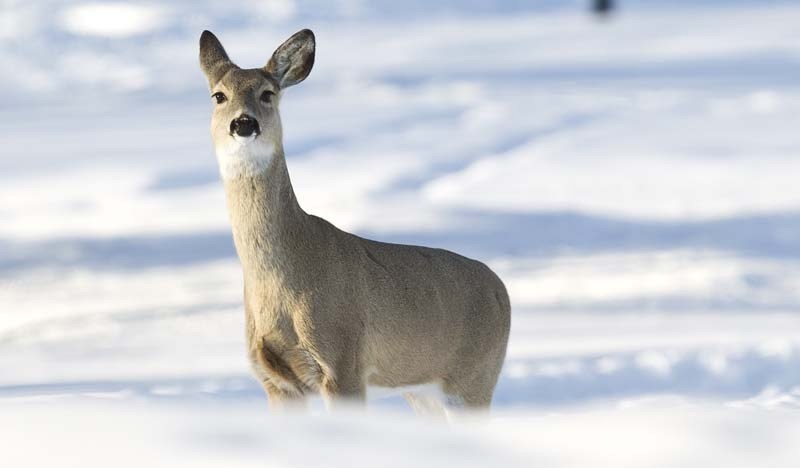It's always a pleasant surprise to spot a white-tailed deer when I'm driving around St. Albert. A short one, too – these fleet-footed quadrupeds invariably run into the bush as soon as I see one, flashing their fluffy white tails as they do so.
It's always a pleasant surprise to spot a white-tailed deer when I'm driving around St. Albert. A short one, too – these fleet-footed quadrupeds invariably run into the bush as soon as I see one, flashing their fluffy white tails as they do so.
White-tailed deer are an important game animal in Alberta, says Hugh Wollis, a local retired wildlife biologist who's written several papers on them. They're a very popular sight for locals, "unless, of course, it's on the grill of your car."
White-tailed deer are very tough to hunt, says Bill Weimann, assistant curator of mammalogy at the Royal Alberta Museum, as they have keen eyes, ears and noses. Most patrol their territory constantly, and can spot an out-of-place hunter instantly. "A soon as they see you, they're gone."
They're also masters of stealth, Wollis says, legendary for hiding in even the smallest bit of cover.
He recalls one constantly snorting deer he calls "Old Gus" who managed to run right between him and his son without either of them spotting him. "We never did catch up to him."
The white-tailed deer is the most common cloven-hoofed mammal in Alberta, reports Alberta Environment, and can be recognized by its red-brown coat (grey-brown in winter) and broad, brown tail. White-tailed deer hold that tail erect when in flight to reveal its white underside, likely as a warning signal to other deer.
You might mistake a white-tailed for a mule deer, Weimann notes.
"You have to basically look at the ears and the white patch on the rump."
Unlike the white-tailed, mule deer have big, donkey-like ears and a white patch on their butts.
You can also observe how they react to you.
"White-tails are notoriously skittish and pretty wired," Weimann says, and will run full-tilt away through the bush at the slightest scent, sight or sound of a human.
A mule deer will be more curious, and will often stand out in the open looking at you before it bounces away.
White-tailed deer are actually a relatively recent addition to northern Alberta, Wollis says, having previously been kept to the south by wolves and buffalo (the latter of which trampled everything the deer could eat). Once European settlers killed those animals and planted high-protein crops like alfalfa, the deer population flourished – to the point of overpopulation, in some areas.
White-tailed deer would have spent the last two months pigging out on crops, saskatoon berries and buds, Wollis says, transforming about 33 per cent of their mass into pure fat. They'll look big and vigorous this month as a result.
That fat is vital to their survival, Wollis reports. White-tailed deer can't dig through more than 10 centimetres of snow, so they usually have to fall back on buds in woodlots in winter. Since they typically munch about 8,000 bites a day, it's very tough for them to find enough to eat – most will be emaciated come spring.
Rutting season
Nov. 18 to 24 is the peak of mating season for white-tailed deer in Alberta, Weimann says (it's triggered by hormonal changes keyed to day-length), and just about the only time you're likely to see male deer (bucks) out in the open.
Bucks will stake out territory by rubbing their antlers and scent glands on trees and peeing on their feet, Weimann says, creating a scent-track called a scrape line. Does who smell these lines will leave their own scent on them, and when the bucks detect that scent, they'll put their heads down and start chasing their potential mate, oblivious to almost everything else. "That's about the only time these guys get shot."
When two competing bucks meet, Wollis says, they'll battle it out using their big antlers.
"They put their antlers down, they back up and they just crash."
One of them will usually back down, but sometimes they'll fight to the death. Unlucky ones will get their horns locked together, spelling doom for both.
Deer don't care about traffic when chasing mates, Wollis notes, which means they can get plastered across the hood of your car if you're not careful.
Drivers should be most watchful for deer around dusk and dawn and around deer-crossing signs, and be extra careful if there is bush on either side of the road.
Slow down, adds Weimann, and watch for little green eyes in the ditch – a sure sign of a deer.
And if you see one of them eating your rose bushes this winter, just remember: the outdoors is their home too.
White-tailed deer
Name:
Odocoileus virginianus.
Appearance:
Reddish-brown or grey-brown quadruped with a brown tail that raises to reveal a white underside when running.
Commonly seen:
Roaming the Sturgeon River valley or culverts, running away from you, eating your rose bushes.
Occasionally confused with:
Mule deer, which have a white patch on their rump and big, donkey-like ears.
Fun fact:
Mothers will often leave their fawns unattended for hours, as the babies are scentless and well-camouflaged. Humans should not touch fawns, as human scent on the fawn may cause the mother to abandon it.
Wild St. Albert
Like wildlife? So do we! Every second Wednesday the Gazette profiles a reasonably common wild creature in the St. Albert region. Birds, beasts, bugs, fish … so long as it's alive and kicking, we'll feature it. <br /><br />Got a creature you'd like to see profiled? Send your suggestions to [email protected].




